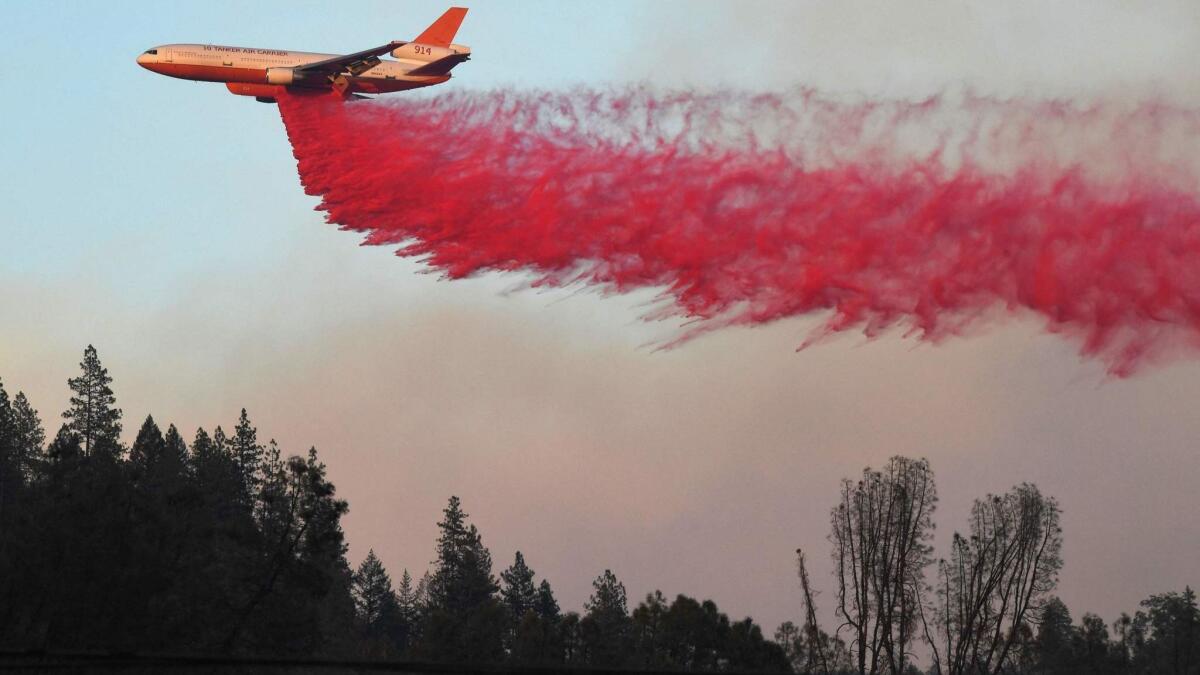California fire explodes to 254,000 acres, making it one of the largest in state history

- Share via
The Mendocino Complex fire continued to grow at an alarming rate, burning 254,000 acres by Sunday morning and becoming fifth largest in California history.
The massive blaze, the most serious of 17 major brush fires burning in California this weekend, was raging across wilderness on both sides of Clear Lake, forcing more evacuations in rural areas of three Northern California counties.
Officials said 15,000 structures are threatened, 68 homes have burned another 12 damaged.
The Mendocino Complex is two fires, the Ranch and River, which have burned in separate directions for days.
Despite the dramatic growth of the fires, authorities said they are making progress.
On Saturday night, “crews had good success increasing containment on the River fire and containment lines were holding well,” the California Department of Forestry and Fire Protection said in a statement. “The strategic plan and operations throughout the previous day held the fire to limited fire spread.”
The Ranch fire had burned 207,000 acres to the north of Clear Lake and was 23% contained; the River fire had burned 47,000 acres to the west of Clear Lake and was 53% contained.
The Mendocino Complex fire is approaching the size of the biggest fire ever recorded in California: December’s Thomas fire, which burned 281,000 acres in Ventura and Santa Barbara counties.
The Ranch and River fires have displaced thousands of residents in Mendocino, Lake and Colusa counties. At least seven evacuation centers and two animal shelters have been operating since the fires broke out.
The Red Cross shelter at the Twin Pines Casino in Middletown has operated much like a revolving door since July 29, as refugees from one end of the Ranch and River fires get word it is safe to return home and new evacuees flee the fires’ advancing edges.
The shelter is set up in a large dome behind the casino, where the slots are still being worked by gamblers. The shelter averages 120 residents a night, and some 42 more people are sleeping in RVs, trailers or their vehicles.
The Pomo tribe in the Robinson Rancheria on the north end of Clear Lake, braced in a valley between the two massive fires, had hopscotched between emergency shelters to wind up in Middletown. About 30 to 40 of the tribe’s men stayed behind, using what little fire equipment they had to mount a defense.
Tribal member Terri Rave, 51, left the rancheria five days ago, after checking to make sure all of the propane tanks were shut off. The tribe’s men, her nephew included, were using tractors and shovels to break up the sod and reduce the vegetation that could burn.
Ventura County Fire Department Capt. Steve Kaufman stopped at the shelter to let evacuees know what was burned and what remained standing after he made a midnight drive through the Ranch fire. But he told them he has no idea what to expect next.
“We can’t predict this one; the new burns each day are as big as fires themselves,” he said. “At different times of the day, the winds are blowing in different directions, pushing the fire in unexpected ways.”
Kaufman said emergency managers are hoping roads, lakes, old fire lines, and the reduced fuel loads on the scars of the 2015 and 2016 Lake County fires will slow down the fast-moving Ranch fire, as will the black burnt soil of last month’s Pawnee fire.
Farther north, near Redding, residents began returning Saturday to neighborhoods ravaged by the Carr fire, which has been linked to the death of seven people and has destroyed more than 1,000 homes.
More than 4,600 firefighters stationed in two Shasta County base camps have battled the 154,000-acre blaze for nearly two weeks, facing triple-digit temperatures, winds up to 30 mph and desert-dry air. It was 41% contained Sunday morning.
The biggest hurdle facing firefighters will be on the fire’s northern edges, where it’s burning through steep creek drainages with unpredictable wind shifts. The goal there, fire commanders say, is to build defensive lines miles ahead of the fire to box it in and attack it directly to minimize its spread.
Numerous media reports have blamed the start of the massive blaze on a vehicle towing a trailer with a flat tire, its metal rim creating sparks as it rolled along. In an interview Saturday evening, Cal Fire officials said the cause of the fire remained under investigation.
Gov. Jerry Brown visited the fire command center at the county fairgrounds on Saturday. Increased year-round fire activity was “the new normal” for the state, he said. The Trump administration issued a federal disaster declaration to aid the firefighting and recovery effort shortly after the governor requested it.
A Pacific Gas & Electric Co. employee doing restoration work in Shasta County died Saturday, a company spokesman said. The employee, 21-year-old Jairus Ayeta, became the seventh death linked to the Carr fire.
“The safety of our employees, contractors and communities we serve is PG&E’s top priority,” said company spokesman J.D. Guidi. “My thoughts are with those involved in the incident and their families.”
The large wildfires burning in the state have scorched over 470,000 acres, displaced around 40,000 residents and are being fought by more than 14,000 firefighters from around the state and country.
The Ferguson fire near Yosemite National Park has burned more than 81,000 acres. Yosemite Valley has been closed since July 25.
More to Read
Sign up for Essential California
The most important California stories and recommendations in your inbox every morning.
You may occasionally receive promotional content from the Los Angeles Times.













